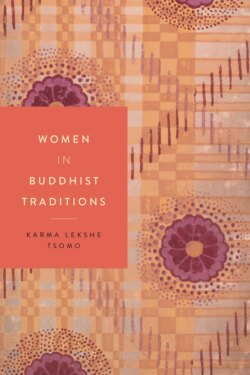Читать книгу Women in Buddhist Traditions - Karma Lekshe Tsomo - Страница 7
На сайте Литреса книга снята с продажи.
Introduction
ОглавлениеWhy Study Women in the Buddhist Traditions?
The story of women in Buddhism is complex, because the world’s Buddhist traditions and the roles of women within them are richly diverse. From India to Japan, Sri Lanka to Russia, each tradition has its unique history, culture, religious life, and cultural mores for women. Moreover, new refractions of each Asian Buddhist tradition are now developing in countries outside of Asia. It may be tempting to slip into simplistic stereotypes about Asian and non-Asian Buddhist women, but Buddhist societies span a multitude of different cultural heritages, geographical settings, and social strata, making it impossible to accurately characterize Buddhist women as a whole. In studying women in Buddhist traditions, therefore, we encounter a major challenge. Is it possible to identify patterns of Buddhist thought and behavior that influence gender roles or reinforce existing patterns of thought and behavior in such a wide spectrum of cultures and societies?
The Buddhist traditions extend over a period of twenty-five centuries, with roots in ancient Indian culture and branches extending to almost every corner of the globe. Not only did Buddhism put down roots over an extensive geographical area, but also these traditions have continued to evolve over a very long period of time, a process that is clearly in evidence throughout the world today. To complicate matters, wherever Buddhist teachings put down roots, they found themselves on soil that was already home to a multitude of indigenous cultures with their own religious traditions. These traditions inevitably influenced, and continue to influence, the ways in which Buddhist ideas and practices are understood and adapted. Tracing the branches and fruits of these culturally specific transmissions and adaptations is as fascinating as it is challenging.
With few early historical materials to work with and countless cultural variations and interpretations, getting a clear picture of women’s roles in the Buddhist traditions is not an easy task. Moreover, as in other religious traditions, women have often been neglected or erased in existing accounts. Nevertheless, after nearly three decades of research on Buddhist women by dedicated scholars in many disciplines, there is more information available today than ever before. In 1987 when, almost by accident, I began doing ethnographic research on Buddhist women, I discovered that very little had been written on the topic. The major study available was I. B. Horner, Women under Primitive Buddhism, published in 1930.
Horner’s work was remarkable for its time and is influential even today, but it surprised me that Buddhist women’s history and ideas had subsequently received so little attention. In many contemporary surveys of Buddhism, the topic of women appears to be simply an add-on. Fortunately, many new books, book chapters, and articles have appeared in the last few decades. Although certain areas of study, such as Buddhist feminist hermeneutics, have barely begun, we have far more information on women in Buddhism available today than ever before.
What can we learn from a study about women in Buddhist traditions? The task here is to provide a broad overview of women in Buddhist societies, taking examples from diverse cultures and communities, to learn what women value in the Buddhist teachings and what obstacles they face in putting those teachings into practice. Our focus will be not on specific social customs but on gaining a broad understanding of the status and self-understanding of women in societies that identify as Buddhist. The objective is not to frame a definitive picture, an impossible task, but to pique readers’ interest in Buddhist women and raise questions for further reading and research. The study of women in Buddhist cultures provides not only a window on the religious lives of women but also a vantage point from which to learn more about Buddhist philosophy, psychology, culture, and society. Despite the variety and complexity of the Buddhist traditions, we can learn a great deal about them through the lives of women.
